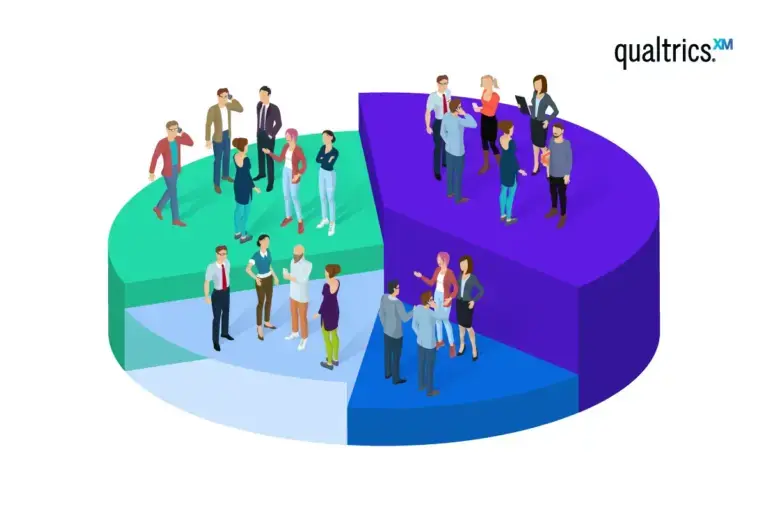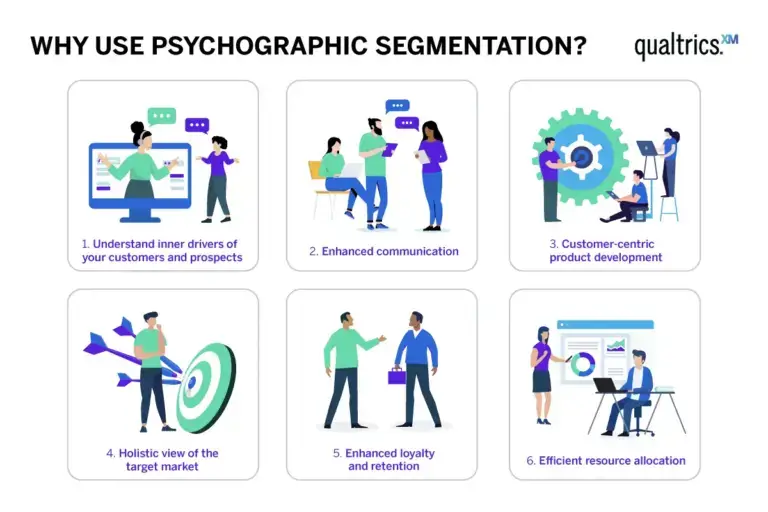What is psychographic segmentation?
Psychographic segmentation is a market research method used to divide a market or customer group into segments based on their beliefs, values, lifestyle, social status, activities, interests and opinions and other psychological criteria.
By drawing out the motivations behind behaviours, psychographic segmentation is a brilliant tool for determining branding and marketing strategy because it enables businesses to build a better overall understanding of their target audience(s). Businesses even use psychographic data to develop products and services that resonate more deeply with specific segments of their market.
Because the attitudes, values and needs that are central to psychographic segmentation are deep rooted and take longer to evolve, psychographic segmentations tend to have a longer shelf life than behavioural and demographic segmentations. Collecting reliable psychographic data, however, can be challenging.

Free eBook: How to drive profits with customer segmentation
6 benefits of psychographic segmentation
Psychographic segmentation offers businesses a nuanced understanding of the intrinsic motivations, desires and lifestyles within their target market. With that information, there’s so much to gain.
Understand inner drivers of your customers and prospects
Psychographic segmentation allows companies to delve deep into the psychological attributes of their customers. This means understanding not just what a customer or prospect might buy, but why they might buy it. By understanding needs, wants, concerns, motivations and aspirations, businesses can tailor what they offer to better align with what their target audience cares about.
Enhanced communication
By understanding people on a personal and emotional level, companies can craft messages that resonate more powerfully. It’s not just about conveying what a product does, but how it fits into a customer’s life, meets their unique desires and addresses their particular challenges – and all in the language a customer segment understands and appreciates.
Customer-centric product development
Psychographic segmentation allows businesses to shape products and services that integrate seamlessly into a customer and prospect’s life. This could mean tweaking a product’s design based on lifestyle preferences, or introducing new services that address specific pain points.
Holistic view of the target market
While behavioural segmentation provides insights based on actions (like purchase history or website visits), psychographic segmentation delves into the reasons behind those actions. This offers a fuller, richer understanding of their target audience, and can help businesses to anticipate future needs and desires.
Enhanced loyalty and retention
Customers tend to be more loyal to brands that ‘get them’.
When businesses tailor their communication and offerings based on psychographic insights, it helps current and prospective customers feel valued and understood – leading to greater trust and, consequently, loyalty. This can soon turn prospects into customers, and customers into powerful brand champions.
Efficient resource allocation
With a deeper understanding of what resonates with different customer segments, businesses can allocate resources more efficiently.
In practical terms, this could mean evolving from generic campaigns to focused, impactful marketing campaigns targeting specific psychographic segments. Beyond being more effective, the ability to create targeted marketing campaigns also means less wastage of marketing dollars.

Using other forms of data to enhance psychographic segmentation
If you want to get the most out of psychographic segmentation, you need to understand that it can’t stand alone: combining psychographic insights with other forms of data enhances the depth and accuracy of what you’re trying to understand.
Demographic data
This provides basic, yet crucial, information about your target audience – factors like age, gender, income and education – to help you frame who they are. With demographic data, you can profile your segments to see which demographics are more or less prevalent in your target segments.
When paired with psychographic data, you can understand, for instance, not just that a person is a middle-aged male, but that he values sustainability and is health-conscious.
Transactional data
Knowing what a customer buys offers a direct line into their preferences and priorities.
By integrating this with psychographic insights and demographic data, you can discern patterns like a young professional (demographics) purchasing eco-friendly products (transactional) because they’re environmentally conscious (psychographic).
Behavioural data
This showcases the customer’s journey, from initial interest to post-purchase interactions.
Merging behavioural data with psychographic data can reveal why certain touchpoints matter more to specific segments. For example, a customer might care more about online reviews (behavioural) because they’re driven by peer validation (psychographic).
Example: Using segmentation to build target market personas
A target market persona is a detailed representation of an ideal customer. More than just a demographic snapshot, it’s a rich profile that can include motivations, preferences, fears and behaviours.
Businesses use target market personas for everything from educating their marketing strategies and messaging, to tailoring content, products and services to resonate more deeply with different customer segments.
When you combine demographic data and psychographic information to build a target market persona, you’re revealing what truly drives that persona’s decisions.
Let’s see how one informs the other to build up an example persona: Meredith, a personal trainer. As we delve into her profile, you’ll notice psychographic segmentation examples that paint a vivid picture of her lifestyle and preferences.
| Demographic profile | Psychographic profile |
|---|---|
| Female | Enjoys healthy living |
| Age 25-45 | Lacks time to herself |
| Married | Enjoys Netflix box sets |
| 2 Children | Buys quality rather than economy |
| Household income $75k+ | Is career-orientated |
| City dweller | Loves going out with girlfriends |
Demographics will only give you the dry facts about Meredith, whereas psychographics will give insight into her potential buying behaviour. This example shows how the two together can give a more holistic picture of a customer.
How to build psychographic segments
Here’s a step-by-step guide to building actionable psychographic segments – and a deeper connection between your brand and its target audience.
1. Define the objective
Clearly articulate the aim behind the segmentation. Whether it’s tailoring a product or refining an ad campaign, pinpoint the specific category of interest. This ensures segmentation is aligned with key business goals and is focused on actionable areas.
2. Design research tools
Develop a research instrument to capture the psychographic attributes related to your category. Psychographic data is almost always quantitative, so consider surveys and questionnaires, and approaches like rank-ordering and multiple choice. Also consider collecting open-ended data – open text fields or video feedback questions are a great way to gather more depth than a structured question.
3. Collect your data
Target a representative sample of your audience, ensuring both appropriate sise and diversity. Whatever your research instrument, prioritise honest and accurate feedback from participants.
4. Analyse your data
Now’s time to find patterns within the data related to your psychographic segmentation variables. Use techniques like factor analysis to discern underlying patterns, and cluster analysis to group respondents by psychographic similarities.
This stage is iterative, as you need to make sure that your segments are actionable. It may be the case that you change the variables that go into the model to ensure that you can both understand and action against your target segments.
5. Name and profile your segments
Give descriptive names to the identified segments to capture their core attributes. Create personas outlining each segment’s key psychographic traits – especially as they relate to the category in focus – and consider using qualitative data to really bring these segments to life.
6. Validate your segments
Now test the relevance of the segments. This can be achieved by cross-referencing with existing customer data, or conducting mini-campaigns to gauge real-world segment responsiveness.
7. Iterate
Continually reassess the segments. As market dynamics and consumer attitudes shift, periodically update your segments to ensure continued relevance. This is also true when there are major changes in the market forces influencing your sector – like, for example, the rapid rise of AI.
Psychographic segmentations do tend to have a longer shelf life than many other types of studies, but don’t take that for granted.
Examples of companies using psychographic segmentation
It should come as no surprise that many of the world’s most successful brands are masters of psychographic segmentation.
Here are some of the best examples of brands developing unique understandings of their segments to create marketing campaigns and industry-changing products.
Patagonia
Recognising the mindset of environmentally conscious outdoor enthusiasts, Patagonia tailored its branding to emphasise sustainability and responsibility.
Their “Don’t Buy This Jacket” campaign challenged consumers to consider the environmental impact of their purchases, advocating for buying less and instead extending the lifespan of each item. Similarly, the brand’s long-lasting Worn Wear initiative encourages customers to trade in their Patagonia gear for repairs. Both speak directly to the eco-conscious values of their target audience.
Snapchat
Tech company Snapchat really got what young people wanted from a messenger app – pioneering a quick, fun and fleeting form of communication. They took this idea further by introducing ‘Stories’, which only lasted 24 hours, and geofilters to let users show where they are in a fun way.
These features tapped into a younger generation’s love for spontaneous online moments.
Harley Davidson
Harley Davidson isn’t just selling motorcycles; they’re selling an experience steeped in freedom, adventure and community. The brand understands that their target audience don’t just see bikes as modes of transport, but as symbols of a distinct lifestyle. By hosting events like the Sturgis Motorcycle Rally, Harley nurtures this sense of belonging and camaraderie.
Their success in psychographic segmentation lies in tapping into these deep-rooted emotions and values, ensuring that their marketing and products resonate with the dreams and aspirations of their audience.
Bring precision to your marketing game
Understanding your audience is the key to effective marketing. Our comprehensive eBook, “How to Drive Profits with Customer Segmentation”, offers the tools and insights you need.
Here’s what’s inside:
- Deep dives into various segmentation categories
- Actionable strategies to truly resonate with your target groups
- Step-by-step guidance on crafting your own segmentation studies
Don’t miss out on leveraging the power of data-driven insights to reach and engage your audience in meaningful ways.
Get the Ebook: How to Drive Profits with Customer Segmentation